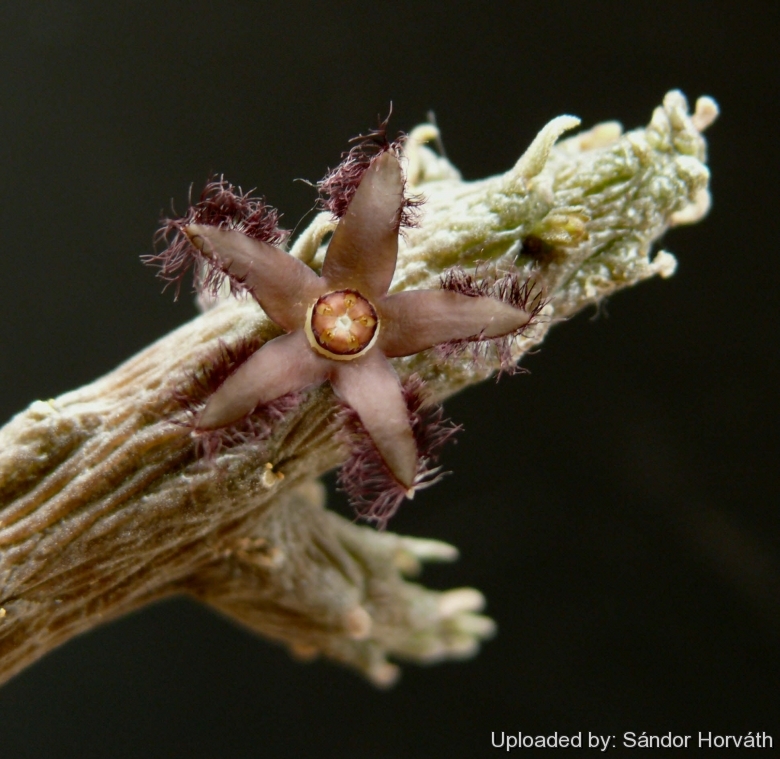




Your support is critical to our success.

Origin and Habitat: South Yemen.
Type Locality: c. 1km E of Al-Barh, 50km W of Ta'izz, c. 500m, 13 27 N, 43 18 E.
Synonyms:
- Rhytidocaulon ciliatum Haná?ek & ?i?ánek
Description: Rhytidocaulon ciliatumSN|32411]]SN|32411]] is a beautiful, branching Rhytidocaulon sp from Yemen forming medium sized clusters. The stems are light to dark brown with a wrinkled, irregularly rough aged texture. The flower appears very different from the other species, it is a light to olive green with purple frilly hairs that blow in the breeze to attract its pollinators (mostly flys). The flower measure more than one centimeter in diameter and is one of the largest open flower in the genus.
Flowers: The inflorescences, are sunken into the stems, and the flowers appears stemless. Corolla 5 lobed c. 1-1.5 cm in diameter. Corolla segments green-yellow, light to olive green or brownish-purple, lanceolate, unpatterned or only softly marked near the bottom of the flower with frilly vibratile hairs on the margins that blow in the breeze to attract its pollinators (flys). Crown segments tightly arranged.
Bibliography: Major references and further lectures
1) HANÁCEK P. & RICÁNEK M., “A new species of Rhytidocaulon (Asclepiadaceae) from Southern Yemen.” Asklepios, 80: 19–22, 2000
2) Ing. Pavel Hanácek, Ph.D “Štúdium genetickej príbuznosti zástupcov rodu Rhytidocaulon pomocou molekulárnych markerov” Bachelor thesis, Mendelova univerzita v Brne, Agronomická fakulta, Ústav biologie rostlin, Brno 2011
Cultivation and Propagation: It is a summer-growing species that like many of the plants of this family which comes from Arabia and Yemen is not easy to cultivate. This plant is extremely xerophytic, adapted to very dry soils and is quite susceptible to over-watering if kept in a non ventilated place.
Growth rate: Relatively fast-growing that offsets freely to form small clusters quickly.
Soil: Grow it in an open mineral, sandy-gritty cactus compost and provide a very good drainage.
Exposure: Keep in part to full shade. It has a good heat tolerance.
Watering: Water during the growing period and let dry out when it is dormant. Mature individuals easily rot and die especially after transplanting so be extremely cautious with watering. Keep dry in winter or when night temperatures remain below 10° C. Water it less than average if in bigger pots.
Fertilization: Feed them once during the growing season with a fertilizer specifically formulated for cactus and succulents (high potash fertilizer with a dilute low nitrogen), including all micro nutrients and trace elements diluted to ½ the strength recommended on the label. They thrive in poor soils and need a limited supplies of fertilizer to avoid the plants developing excess vegetation, which is easily attacked by fungal diseases.
Special need: It is suited for airy exposures. Provide very good ventilation. Nearly all problems occur as a result of overwatering and poor ventilation, especially when weather conditions are dull and cool or very humid. They must have very dry atmosphere.
Hardiness: It will not tolerate low temperatures (recommended minimum winter temperature 5° to 10° C)
Pests & diseases: These succulents may be attractive to a variety of insects, but plants in good condition should be nearly pest-free, particularly if they are grown in a mineral potting-mix, with good exposure and ventilation. Nonetheless, there are several pests to watch for:
- Mealy bugs: Mealy bugs occasionally develop aerial into the new leaves and flowers with disfiguring results, but the worst types develop underground on the roots and are invisible except by their effects.
- Rot: This species will not tolerate high humidity, frequently succumbing to fungal attacks if kept in sub-optimal conditions. If they are not watered and “aired” correctly, fungicides won't help all that much.
Propagation: Seeds, cuttings or grafting.
| Your Actions | |
|---|---|
| Back to Rhytidocaulon index | |
| Back to Asclepiadaceae index | |
 |
Back to Succulents Encyclopedia index |
Privacy stantement - Terms and conditions - How to cite - About us - Feedback - Donate



